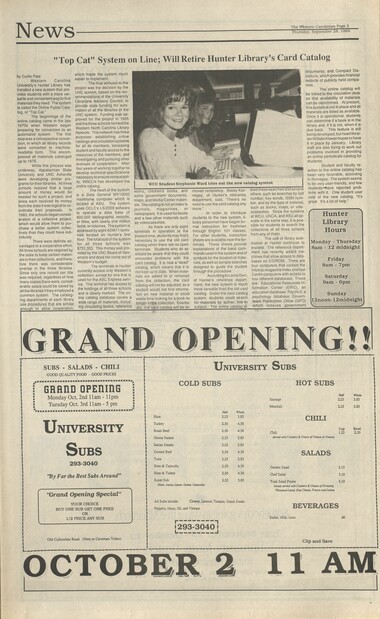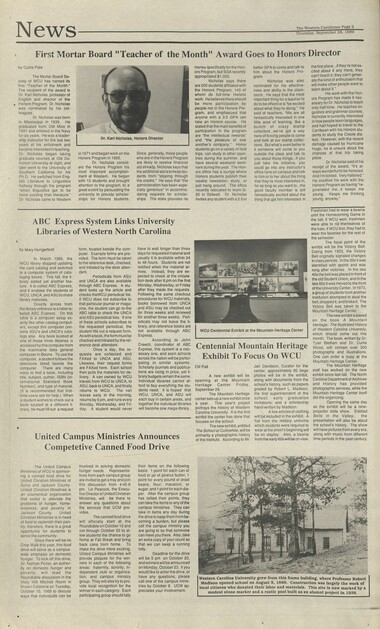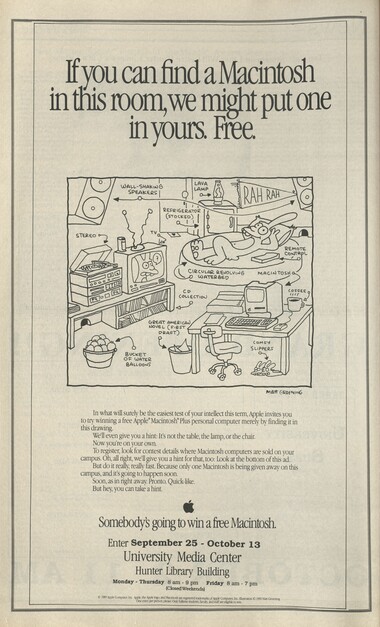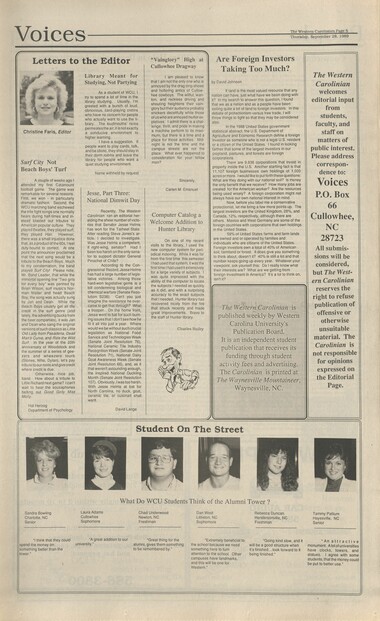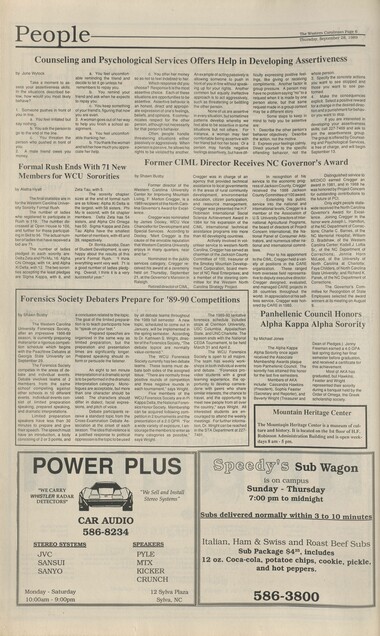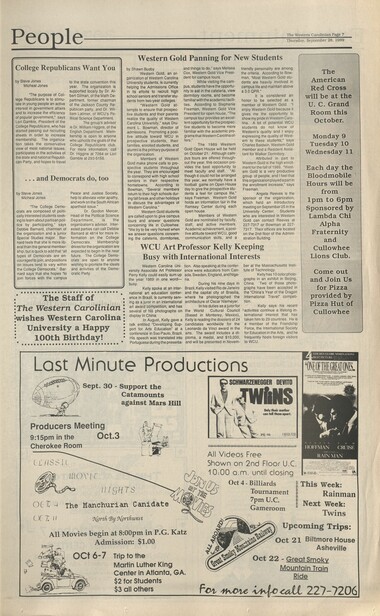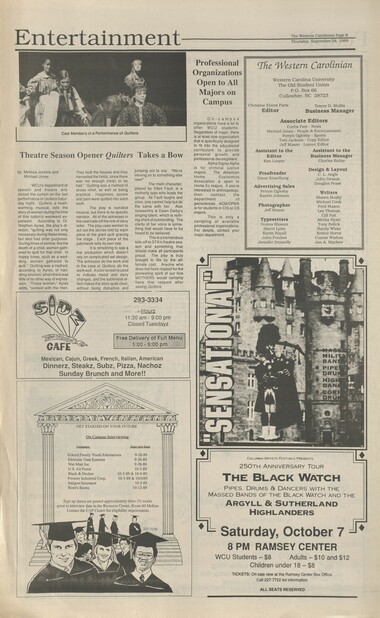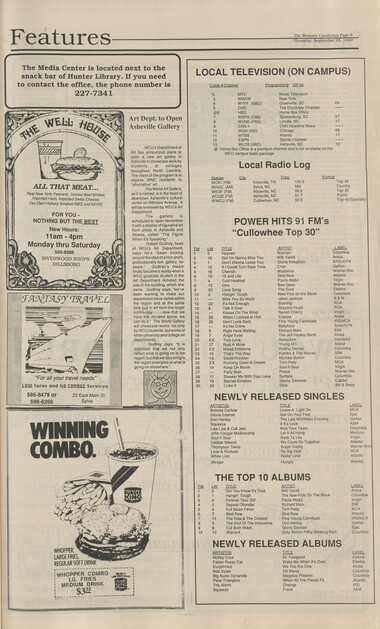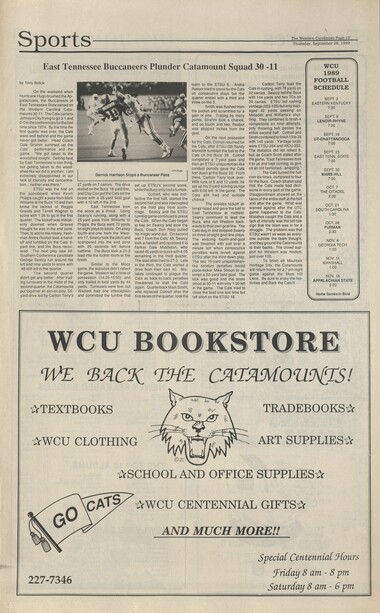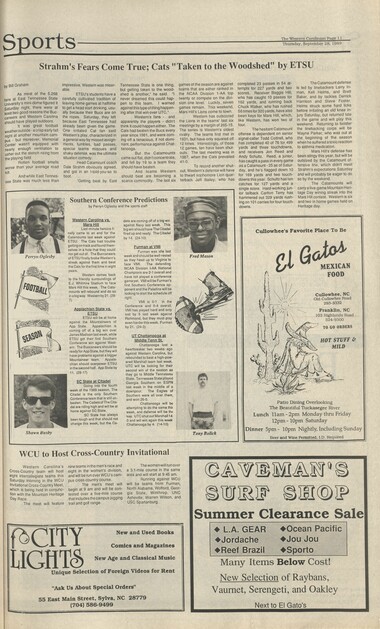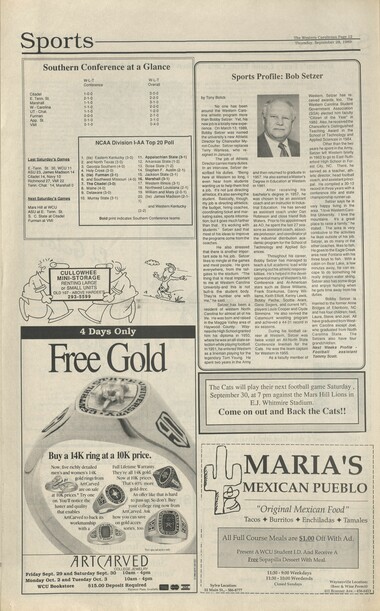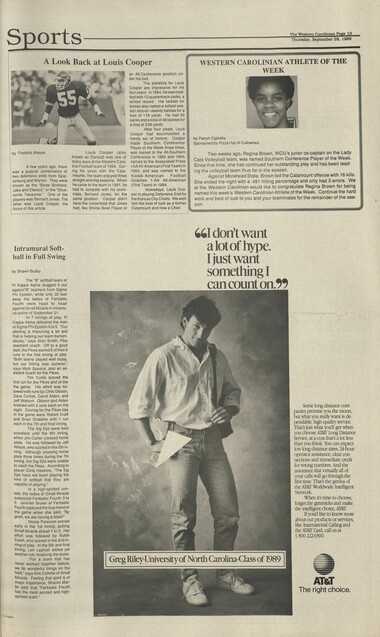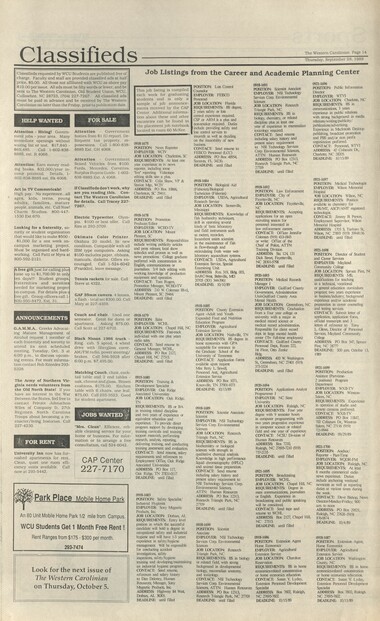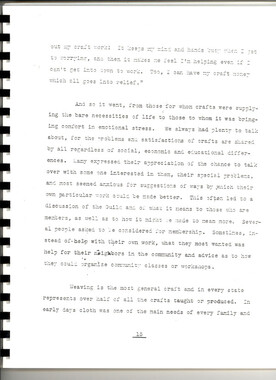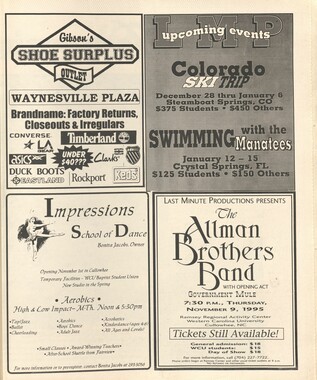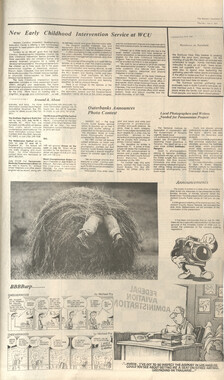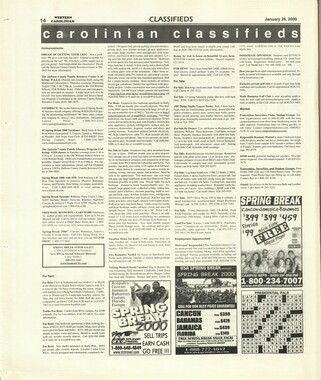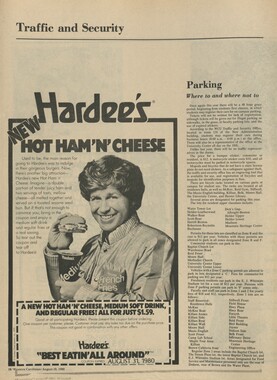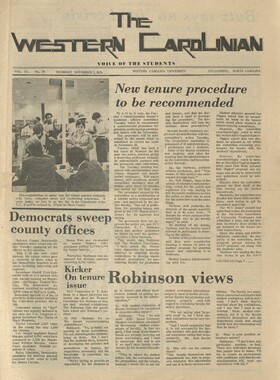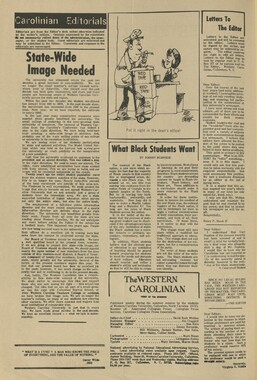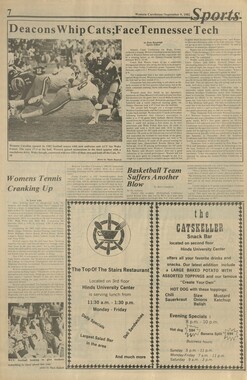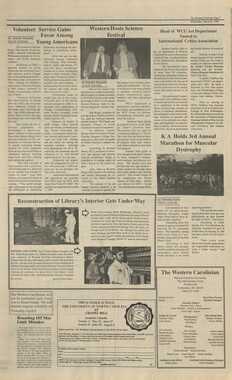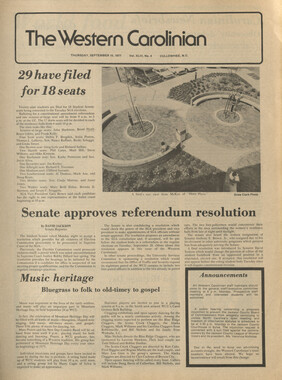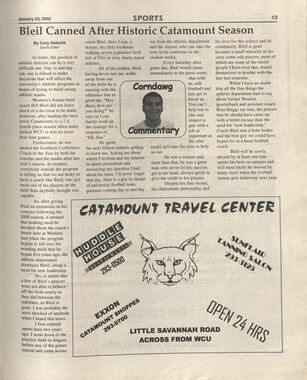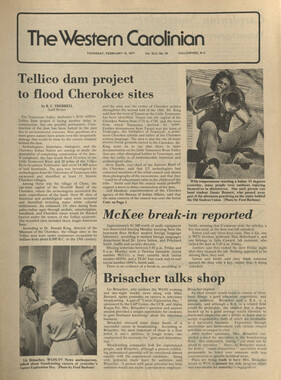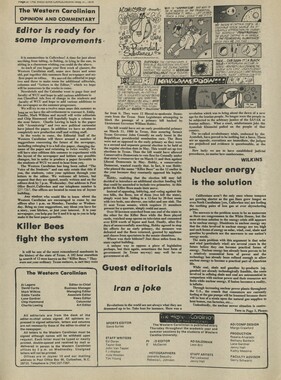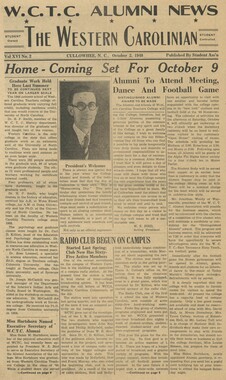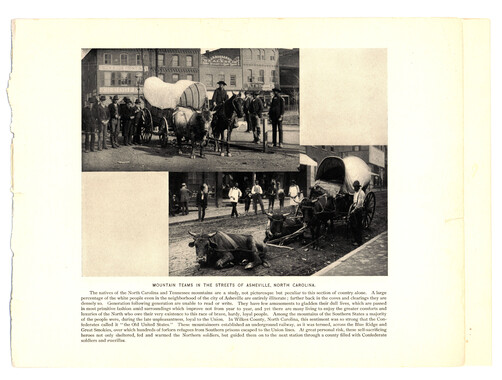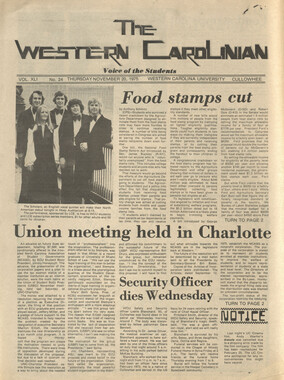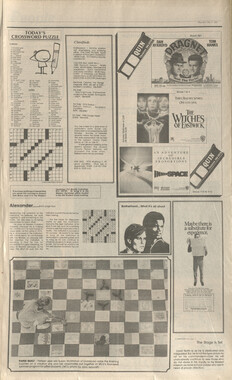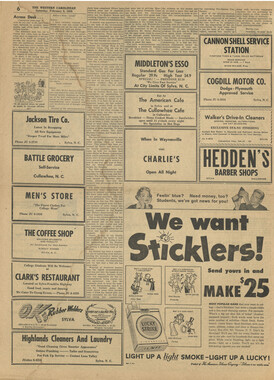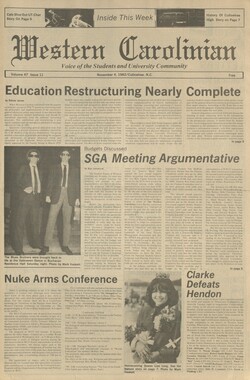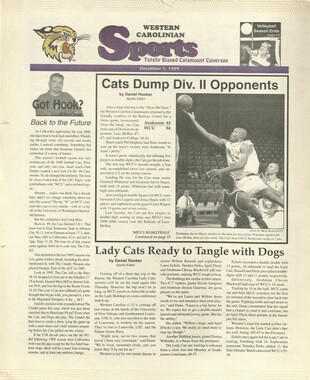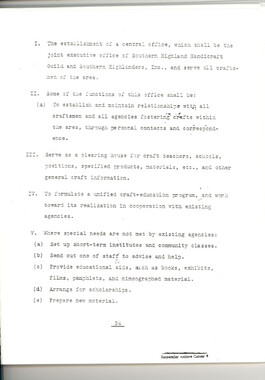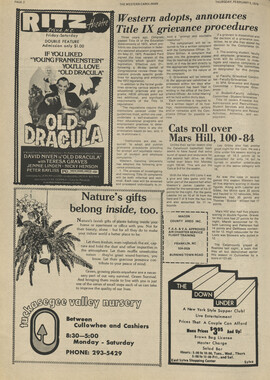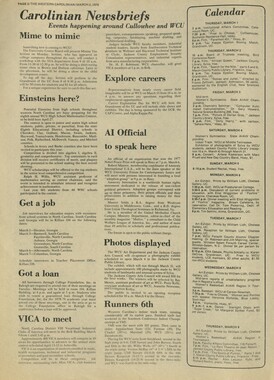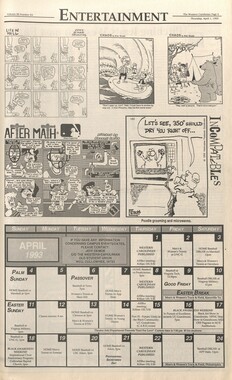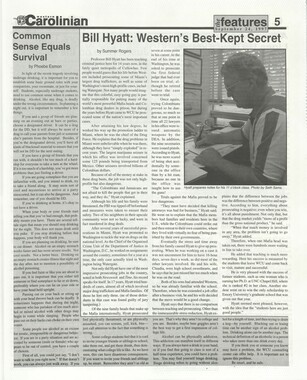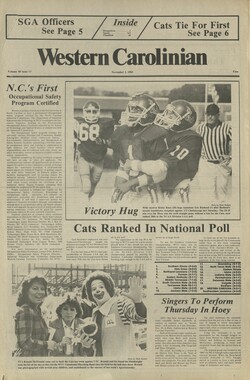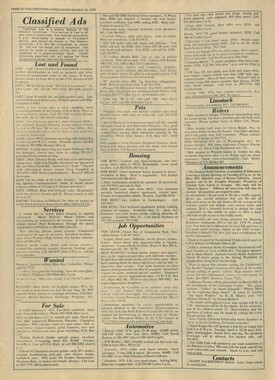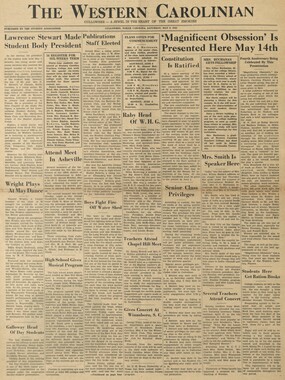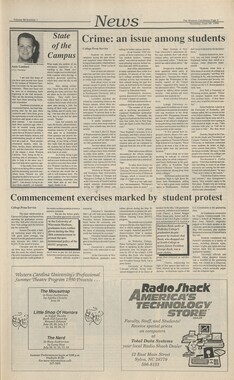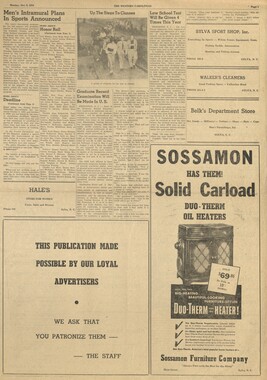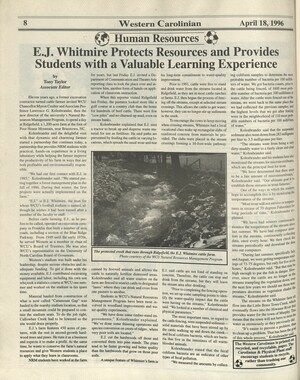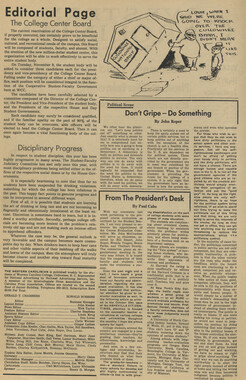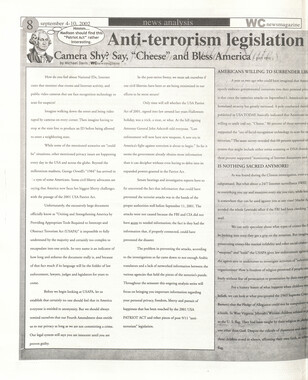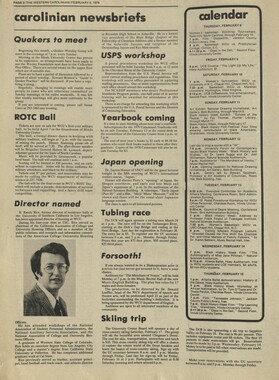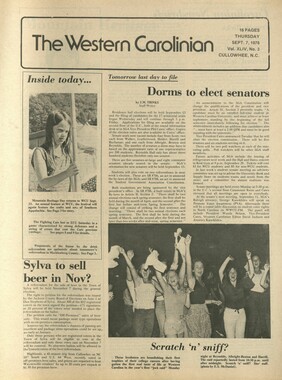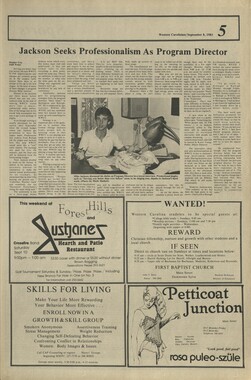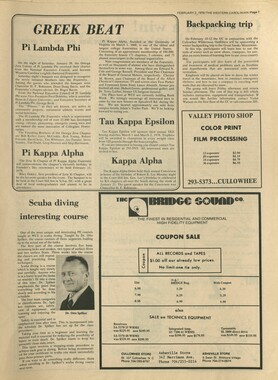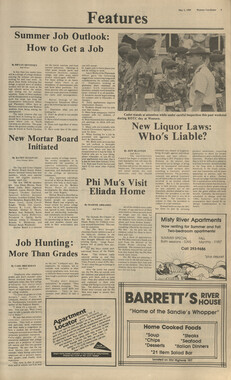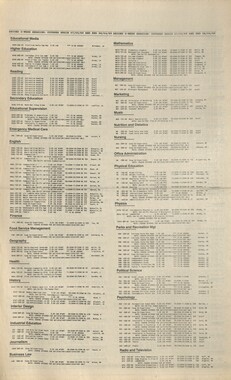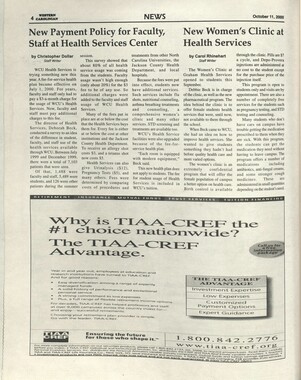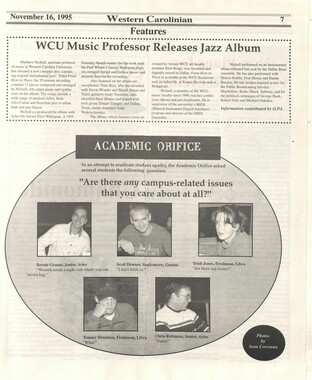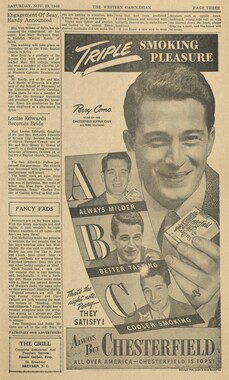Western Carolina University (20)
View all
- Canton Champion Fibre Company (2308)
- Cherokee Traditions (293)
- Civil War in Southern Appalachia (165)
- Craft Revival (1942)
- Great Smoky Mountains - A Park for America (2767)
- Highlights from Western Carolina University (430)
- Horace Kephart (941)
- Journeys Through Jackson (154)
- LGBTQIA+ Archive of Jackson County (26)
- Oral Histories of Western North Carolina (314)
- Picturing Appalachia (6772)
- Stories of Mountain Folk (413)
- Travel Western North Carolina (160)
- Western Carolina University Fine Art Museum Vitreograph Collection (129)
- Western Carolina University Herbarium (92)
- Western Carolina University: Making Memories (708)
- Western Carolina University Publications (2283)
- Western Carolina University Restricted Electronic Theses and Dissertations (146)
- Western North Carolina Regional Maps (71)
- World War II in Southern Appalachia (131)
University of North Carolina Asheville (6)
View all
- Allanstand Cottage Industries (62)
- Appalachian National Park Association (53)
- Bennett, Kelly, 1890-1974 (1388)
- Berry, Walter (76)
- Brasstown Carvers (40)
- Carver, George Washington, 1864?-1943 (26)
- Cathey, Joseph, 1803-1874 (1)
- Champion Fibre Company (233)
- Champion Paper and Fibre Company (297)
- Cherokee Indian Fair Association (16)
- Cherokee Language Program (22)
- Crowe, Amanda (40)
- Edmonston, Thomas Benton, 1842-1907 (7)
- Ensley, A. L. (Abraham Lincoln), 1865-1948 (275)
- Fromer, Irving Rhodes, 1913-1994 (70)
- George Butz (BFS 1907) (46)
- Goodrich, Frances Louisa (120)
- Grant, George Alexander, 1891-1964 (96)
- Heard, Marian Gladys (60)
- Kephart, Calvin, 1883-1969 (15)
- Kephart, Horace, 1862-1931 (313)
- Kephart, Laura, 1862-1954 (39)
- Laney, Gideon Thomas, 1889-1976 (439)
- Masa, George, 1881-1933 (61)
- McElhinney, William Julian, 1896-1953 (44)
- Niggli, Josephina, 1910-1983 (10)
- North Carolina Park Commission (105)
- Osborne, Kezia Stradley (9)
- Owens, Samuel Robert, 1918-1995 (11)
- Penland Weavers and Potters (36)
- Roberts, Vivienne (15)
- Roth, Albert, 1890-1974 (142)
- Schenck, Carl Alwin, 1868-1955 (1)
- Sherrill's Photography Studio (2565)
- Southern Highland Handicraft Guild (127)
- Southern Highlanders, Inc. (71)
- Stalcup, Jesse Bryson (46)
- Stearns, I. K. (213)
- Thompson, James Edward, 1880-1976 (226)
- United States. Indian Arts and Crafts Board (130)
- USFS (683)
- Vance, Zebulon Baird, 1830-1894 (1)
- Weaver, Zebulon, 1872-1948 (58)
- Western Carolina College (230)
- Western Carolina Teachers College (282)
- Western Carolina University (1794)
- Western Carolina University. Mountain Heritage Center (18)
- Whitman, Walt, 1819-1892 (10)
- Wilburn, Hiram Coleman, 1880-1967 (73)
- Williams, Isadora (3)
- Cain, Doreyl Ammons (0)
- Crittenden, Lorraine (0)
- Rhodes, Judy (0)
- Smith, Edward Clark (0)
- Appalachian Region, Southern (2399)
- Asheville (N.C.) (1917)
- Avery County (N.C.) (26)
- Blount County (Tenn.) (161)
- Buncombe County (N.C.) (1671)
- Cherokee County (N.C.) (283)
- Clay County (N.C.) (555)
- Graham County (N.C.) (233)
- Great Smoky Mountains National Park (N.C. and Tenn.) (510)
- Haywood County (N.C.) (3522)
- Henderson County (N.C.) (70)
- Jackson County (N.C.) (4692)
- Knox County (Tenn.) (25)
- Knoxville (Tenn.) (12)
- Lake Santeetlah (N.C.) (10)
- Macon County (N.C.) (420)
- Madison County (N.C.) (211)
- McDowell County (N.C.) (39)
- Mitchell County (N.C.) (132)
- Polk County (N.C.) (35)
- Qualla Boundary (981)
- Rutherford County (N.C.) (76)
- Swain County (N.C.) (2113)
- Transylvania County (N.C.) (247)
- Watauga County (N.C.) (12)
- Waynesville (N.C.) (73)
- Yancey County (N.C.) (72)
- Aerial Photographs (3)
- Aerial Views (60)
- Albums (books) (4)
- Articles (1)
- Artifacts (object Genre) (228)
- Bibliographies (1)
- Biography (general Genre) (2)
- Cards (information Artifacts) (38)
- Clippings (information Artifacts) (191)
- Crafts (art Genres) (622)
- Depictions (visual Works) (21)
- Design Drawings (1)
- Drawings (visual Works) (184)
- Envelopes (73)
- Facsimiles (reproductions) (1)
- Fiction (general Genre) (4)
- Financial Records (12)
- Fliers (printed Matter) (67)
- Glass Plate Negatives (381)
- Guidebooks (2)
- Internegatives (10)
- Interviews (812)
- Land Surveys (102)
- Letters (correspondence) (1013)
- Manuscripts (documents) (619)
- Maps (documents) (177)
- Memorandums (25)
- Minutes (administrative Records) (59)
- Negatives (photographs) (5835)
- Newsletters (1285)
- Newspapers (2)
- Occupation Currency (1)
- Paintings (visual Works) (1)
- Pen And Ink Drawings (1)
- Periodicals (193)
- Personal Narratives (10)
- Photographs (12976)
- Plans (maps) (1)
- Poetry (7)
- Portraits (1960)
- Postcards (329)
- Programs (documents) (151)
- Publications (documents) (2237)
- Questionnaires (65)
- Scrapbooks (282)
- Sheet Music (2)
- Slides (photographs) (402)
- Songs (musical Compositions) (2)
- Sound Recordings (796)
- Specimens (92)
- Speeches (documents) (15)
- Tintypes (photographs) (8)
- Transcripts (322)
- Video Recordings (physical Artifacts) (23)
- Vitreographs (129)
- Text Messages (0)
- A.L. Ensley Collection (275)
- Appalachian Industrial School Records (7)
- Appalachian National Park Association Records (336)
- Axley-Meroney Collection (2)
- Bayard Wootten Photograph Collection (20)
- Bethel Rural Community Organization Collection (7)
- Blumer Collection (5)
- C.W. Slagle Collection (20)
- Canton Area Historical Museum (2110)
- Carlos C. Campbell Collection (282)
- Cataloochee History Project (65)
- Cherokee Studies Collection (4)
- Daisy Dame Photograph Album (5)
- Daniel Boone VI Collection (1)
- Doris Ulmann Photograph Collection (112)
- Elizabeth H. Lasley Collection (1)
- Elizabeth Woolworth Szold Fleharty Collection (4)
- Frank Fry Collection (95)
- George Masa Collection (173)
- Gideon Laney Collection (452)
- Hazel Scarborough Collection (2)
- Hiram C. Wilburn Papers (28)
- Historic Photographs Collection (236)
- Horace Kephart Collection (861)
- Humbard Collection (33)
- Hunter and Weaver Families Collection (1)
- I. D. Blumenthal Collection (4)
- Isadora Williams Collection (4)
- Jesse Bryson Stalcup Collection (47)
- Jim Thompson Collection (224)
- John B. Battle Collection (7)
- John C. Campbell Folk School Records (80)
- John Parris Collection (6)
- Judaculla Rock project (2)
- Kelly Bennett Collection (1407)
- Love Family Papers (11)
- Major Wiley Parris Civil War Letters (3)
- Map Collection (12)
- McFee-Misemer Civil War Letters (34)
- Mountain Heritage Center Collection (4)
- Norburn - Robertson - Thomson Families Collection (44)
- Pauline Hood Collection (7)
- Pre-Guild Collection (2)
- Qualla Arts and Crafts Mutual Collection (12)
- R.A. Romanes Collection (681)
- Rosser H. Taylor Collection (1)
- Samuel Robert Owens Collection (94)
- Sara Madison Collection (144)
- Sherrill Studio Photo Collection (2558)
- Smoky Mountains Hiking Club Collection (616)
- Stories of Mountain Folk - Radio Programs (374)
- The Reporter, Western Carolina University (510)
- Venoy and Elizabeth Reed Collection (16)
- WCU Gender and Sexuality Oral History Project (32)
- WCU Mountain Heritage Center Oral Histories (25)
- WCU Oral History Collection - Mountain People, Mountain Lives (71)
- WCU Students Newspapers Collection (1744)
- Western North Carolina Tomorrow Black Oral History Project (69)
- William Williams Stringfield Collection (2)
- Zebulon Weaver Collection (109)
- African Americans (390)
- Appalachian Trail (35)
- Artisans (521)
- Cherokee art (84)
- Cherokee artists -- North Carolina (10)
- Cherokee language (21)
- Cherokee pottery (101)
- Cherokee women (208)
- Church buildings (167)
- Civilian Conservation Corps (U.S.) (110)
- College student newspapers and periodicals (1830)
- Dams (103)
- Dance (1023)
- Education (222)
- Floods (61)
- Folk music (1015)
- Forced removal, 1813-1903 (2)
- Forest conservation (220)
- Forests and forestry (921)
- Gender nonconformity (4)
- Great Smoky Mountains National Park (N.C. and Tenn.) (181)
- Hunting (38)
- Landscape photography (10)
- Logging (103)
- Maps (84)
- Mines and mineral resources (8)
- North Carolina -- Maps (18)
- Paper industry (38)
- Postcards (255)
- Pottery (135)
- Railroad trains (71)
- Rural electrification -- North Carolina, Western (3)
- School integration -- Southern States (2)
- Segregation -- North Carolina, Western (5)
- Slavery (5)
- Sports (452)
- Storytelling (245)
- Waterfalls -- Great Smoky Mountains (N.C. and Tenn.) (66)
- Weaving -- Appalachian Region, Southern (280)
- Wood-carving -- Appalachian Region, Southern (328)
- World War, 1939-1945 (173)
Western Carolinian Volume 55 Number 06
Item
Item’s are ‘child’ level descriptions to ‘parent’ objects, (e.g. one page of a whole book).
-
-
News The Western Carolinian Page 3 Thursday, September 28, 1989 "Top Cat" System on Line; Will Retire Hunter Library's Card Catalog by Curtis Pate Western Carolina University's Hunter Library has installed a new system that provides students with a more versatile and convenient way to find materials they need. The system is called the Online Public Catalog, or "Top Cat." The beginnings of the online catalog came in the late 1970s when Western began preparing for conversion to an automated system. The first step was a retrospective conversion, in which all library records were converted to machine- readable form. This encompassed all materials cataloged up to 1975. While this process was underway, Appalachian State University and UNC Asheville were developing similar programs fortheir libraries. All three schools realized that a large amount of money would be needed for such a project, and since each received its money from the state it was logical to coordinate their proposals. In 1983, the schools began consideration of a collective project, which would allow them to purchase a better system collectively than they could have individually. There were definite advantages to a cooperative effort. All three schools are required by the state to keep certain materi- als-in their collections, and therefore there was considerable overlap in the three libraries. Since only one record per title was required, regardless of how many copies there were, considerable space could be saved by all the libraries if they employed a common system. The cataloging departments of each library use procedures that are similar enough to allow cooperation, which made the system much easier to implement. The final stimulus to the project was the decision by the UNC system, based on the recommendations of the University Librarians Advisory Council, to provide state funding for automation of all the libraries of the UNC system. Funding was approved for the project in 1985 and the three schools formed the Western North Carolina Library Network. This network has three purposes: establishing online catalogs and circulation systems for all its members, increasing student and faculty access to the resources of the members, and investigating and pursuing other avenues of cooperation. After four years of working together to develop technical specifications necessary to ensure compatabil- ity, WNCLN has developed the online catalog. The heart of the system is a Data General MV10000 mainframe computer which is located at ASU. The system uses OCLC's LS/2000 software to operate a data base of 600,000 bibliographic records, or titles, with nearly one million items, or volumes. The system is accessed by eight ADM 11 terminals located on Hunter's first floor. The total cost of the system for all three schools was $733,353. This money was provided by the UNC Board of Governors and does not come out of Western's budget. The terminals in Hunter currently access only Western's collection, except for one that is used for the ABC Express service. This terminal has access to the holdings of all three schools and is clearly marked. The online catalog database covers a wide range of materials, including circulating books, reference works, children's books, and some government documents, maps, and Media Center materials. The catalog is not an index to journals, magazines, or newspapers. It is used for books and a few other materials such as videocassettes. As there are only eight terminals in operation at the present time, students may find it necessary to use the old card catalog when there are no open terminals. Students who do so should be aware that they could encounter problems with the card catalog. It is now a "dead" catalog, which means that it is not kept up to date. When materials are added to or removed from the collection, the card catalog will not be adjusted, so a student would not find information on new material or could waste time looking for a book no longer in the collection. Eventu- ally, the card catalog will be re- moved completely. Becky Kornegay, of Hunter's reference department, said, "There's no need to use the card catalog any more." In order to introduce students to the new system, library personnel have begun formal instruction for freshmen through English 101 classes. For other students, instruction sheets are available near the terminals. These sheets provide explanations of the basic commands used in the system and of symbols for the location of materials, as well as sample searches designed to guide the student through the procedure. AccordingtoLornaDorr, of Hunter's reference department, the new system is much more versatile than the old card catalog. Under the card catalog system, students could search for materials by author, title 'er subject. The online catalog al- W lows these searches and several others, such as searches by call number, key words, ISBN number, and by the type of material, such as books, maps, or videocassettes. Since the systems at WCU, UNCA, and ASU all operate in the same way, it is possible for students to search the collections of all three schools from any of them. The use of library automation at Hunter continues to expand. The reference department has recently added machines that allow access to databases on CD/ROM. There are four computers that contain the Infotrac magazine index andfour Zenith computers with access to four different databases. These are: Educational Resources Information Center (ERIC), an education database; PsychLit, a psychology database; Government Publication Office (GPO) Which indexes government documents; and Compact Disclosure, which provides financial records of publicly held companies. The online catalog will be linked to the circulation desk so that availability of materials can be determined. At present, this system is not in place and all materials are listed as available. Once it is operational, students can determine if a book is in the library and, if it is not, when it is due back. This feature is still being developed, but head librarian William Kirwan hopes to have it in place by January. Library staff are also trying to work out problems involved in providing an online periodicals catalog for students. Student and faculty reaction to the online catalog has been very favorable, according to Kornegay. The system seems to be very user-friendly, and few students-+iave reported problems with it. One student user said of the new catalog, "It's great. It's a lot of help." Hunter Library Hours Monday - Thursday 8am - 12 midnight Friday 8am - 7pm Saturday 9am - 6pm Sunday 12 noon-12mi dnight 7" j SUBS - SALADS - CHILI GOOD QUALITY FOOD - GOOD PRICES University Subs r" u. iiiiiii>iii(imiiiiiii»iii»i» GRflllD OPEnillG Monday Oct, 2nd 11am - 11pm Tuesday Oct. 3rd 11am - 5 pm ^ COLD SUBS HOT SUBS Sausage Meatball Half 125 2.25 Whole 3.85 3.85 University Subs 293-3040 "By Far the Best Subs Around" Half Whole Ham 2J25 3.85 Turkey 2.50 4.30 Roast Beef 2.50 4.30 Genoa Salami 2.25 3.85 Italian Salami 2.25 3.85 Corned Beef 2.50 4.30 Tuna 2J25 3.85 Ham & Capicolla 2.50 4.30 Ham & Turkey 2.50 4.30 Super Sub 2^5 3.85 (Ham. Italian Salami, Genoa, Capicolla) CHILI Cup Chili 1.25 served with Crackers & Choice of Cheese or Onions Bowl 2.50 SALADS Garden Salad Chef Salad 2.15 3.10 "Grand Opening Special" YOUR CHOICE BUY ONE SUB GET ONE FREE OR 1/2 PRICE ANY SUB Tuna Salad Platter 3.10 Salads served with Crackers <4 Choice of Dressing Thousand Island, Blue Cheese, French and Italian All Subs include: Cheese, Lettuce, Tomato, Onion Sweet Peppers, Mayo, Oil, and Vinegar ^93-30401 i i BEVERAGES Sodas, Milk, Juice .60 Old Cullowhee Road (Next to Caveman Video) Clip and Save 2/ 11 AM
Object
Object’s are ‘parent’ level descriptions to ‘children’ items, (e.g. a book with pages).
-
The Western Carolinian is Western Carolina University's student-run newspaper. The paper was published as the Cullowhee Yodel from 1924 to 1931 before changing its name to The Western Carolinian in 1933.
-
